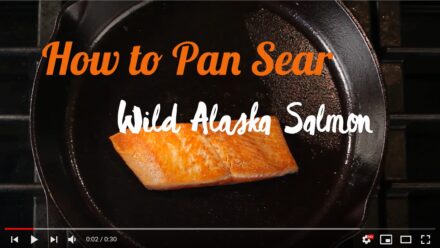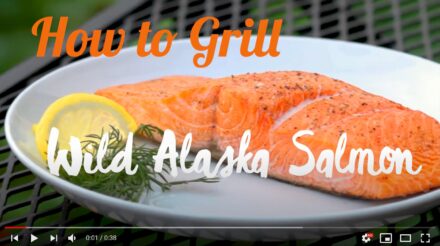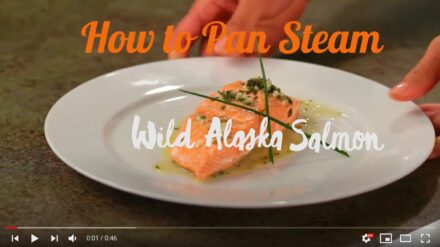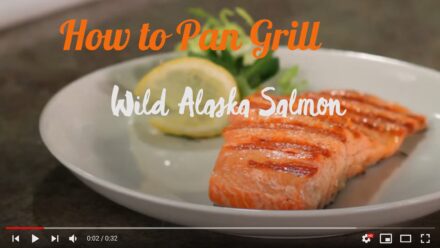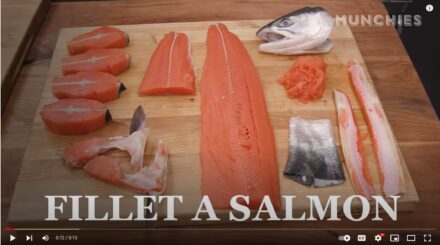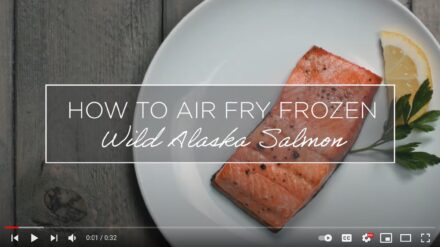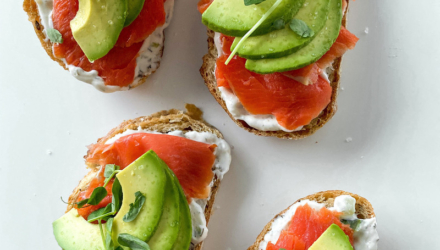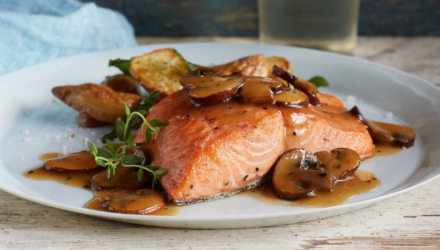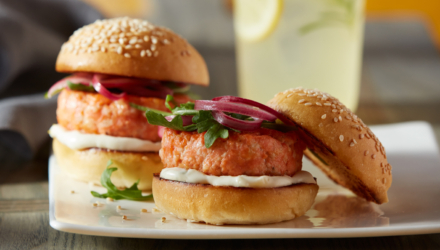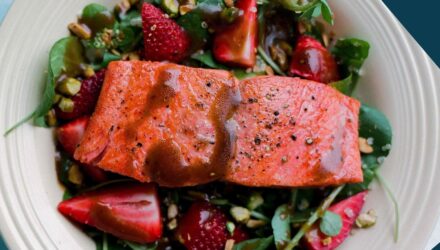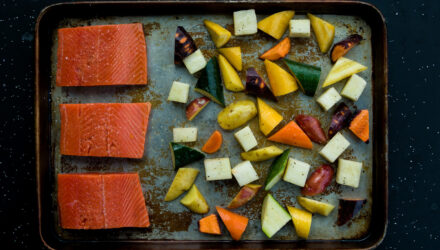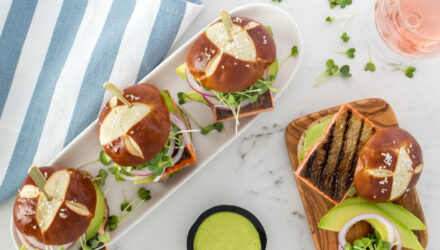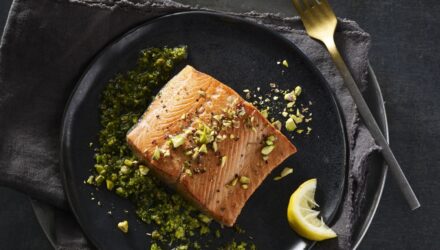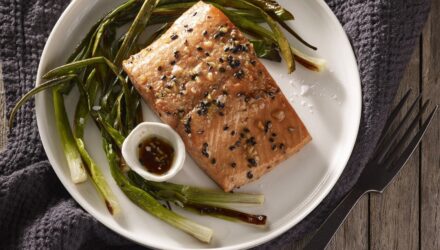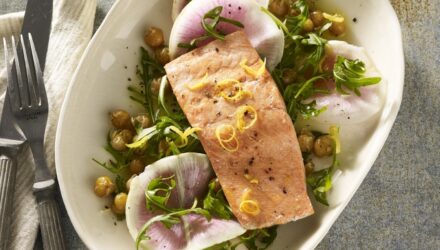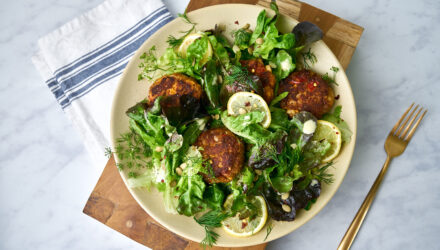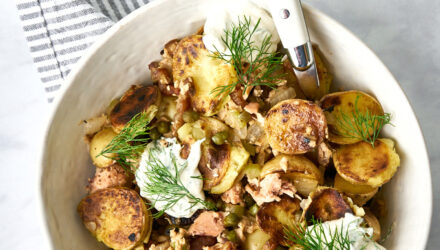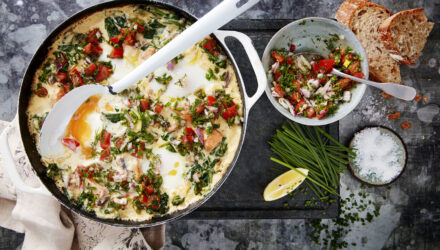Cooking with Wild Alaska Salmon

Salmon from Alaska:
Truly Wild, Natural and Sustainable®
Alaska salmon is a perfect star-of-the-plate protein ready for any meal, from snacks with the kids to your next dinner party.
Swimming wild and free in their natural habitat – the strong currents of the North Pacific – the cold waters and pristine environment of Alaska produces lean seafood with a firm texture and succulent flavor. All Alaska seafood is wild and pure, responsibly managed for continued abundance.

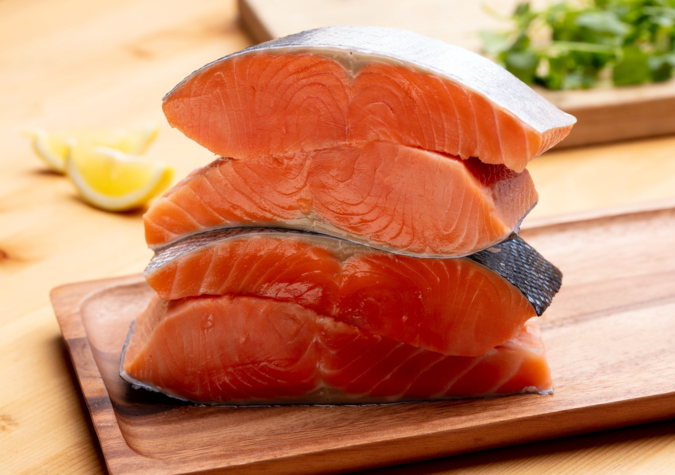
There are five delicious species of wild Alaska salmon to choose from
The rich flavor and firm texture of king, sockeye and coho salmon make them a terrific choice for any cooking method, from grilling and broiling to sautéing, roasting, poaching and steaming. The leaner keta and pink salmon are excellent choices for sautéing or baking in flavorful sauces and as a quick and healthy protein in salads or pastas.
Salmon Cooking Techniques, Tips, & Recipes
Get Inspired with Easy Salmon Recipes
Cooking Thawed & Fresh Salmon
It’s easy to cook thawed and fresh salmon following these steps for healthy meals in minutes.
Need something for dinner tonight? Try our quick-thaw method in this video.

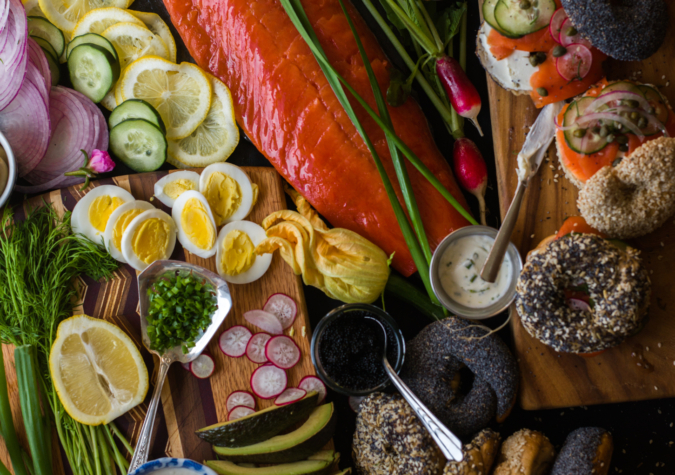
Quick Cooking Tips
Equipment: For stovetop grilling and sauteing. use a heavy nonstick skillet or ridged stovetop grill pan
Temperature: Pans. grill and oven/broiler must be hot (around 400″F) before cooking starts. Test the temperature of a stovetop pan by sprinkling a few drops of water on the skillet; if they immediately pop off the surface. the pan is ready.
Spare the Spices: When sauteing or stovetop grilling, avoid seasoning the fish with dry spices before it is placed in the pan. The spices will burn and stick to the pan. It is best to season salmon after you flip it.
Cook Just Until Done: Salmon turns from translucent to opaque as it cooks and will continue to cook after it is removed from the heat source. To check for doneness, slide a sharp knife tip into the center of the thickest part of a cooking salmon portion. checking for color. Adjust cook time as needed for salmon thickness and cook just until salmon is opaque throughout.
Thawed & Fresh Cooking Techniques
-
Saute & Pan Sear from Thawed & Fresh
-
Instructions
- Heat a heavy nonstick skillet or ridged stovetop grill pan over medium-high heat.
- While the pan heats, add oil or a combination of oil and butter to the pan.
- Season the salmon with spices and place it in heated pan, skin side up, and cook, uncovered, 3 to 4 minutes or until browned.
- Turn the salmon over and continue to cook, uncovered, an additional 3 to 4 minutes.
- For very thick portions, finish in oven preheated to 400°F (use ovenproof pan).
Cooking Technique Video
Try This Recipe -
Bake, Roast & Broil from Thawed & Fresh
-
Instructions
- Preheat broiler/oven to medium-high heat (450°F).
- Brush both sides of salmon with oil.
- Place salmon on spray-coated broiling pan or foil-lined baking sheet.
- Cook 10 to 12 minutes.
- Flip only very thick portions.
-
Grill from Thawed & Fresh
-
Instructions
- Thoroughly clean and preheat the grill to 450°F.
- Oil both the grill and the salmon to prevent sticking.
- Marinate or season the salmon; place it on the grill.
- Cook 8 to 10 minutes, turning once during cooking.
Cooking Technique Videos
Try This Recipe -
Steam & Instant Pot from Thawed & Fresh
-
Instructions
- Bring about 1-inch of water/seasoned liquid to a boil.
- Turn off heat; place bamboo steamer basket, wire basket or vegetable steamer in pan.
- Line the steamer with lettuce, onion, herbs or citrus (without covering all of the holes) to keep salmon from sticking and add salmon.
- Return liquid to a boil.
- Cover loosely and steam 4 to 5 minutes for fresh/thawed salmon.
Cooking Technique Video
Try This Recipe
Thawed & Fresh Salmon Recipes
Cooking Salmon from Frozen
Want to prepare a quick Alaska salmon dinner, but the salmon you have on hand is frozen? No problem!
With COOK IT FROZEN!® techniques and recipes, there’s no need to thaw frozen salmon portions. Cook frozen wild Alaska salmon for a delicious meal in as little as 15 minutes.
Quick Tip: Before cooking frozen salmon portions, rinse off any ice glaze under cold water; pat dry with a paper towel.
-
Saute & Pan-Sear from Frozen
-
Instructions
- Heat a heavy nonstick skillet or ridged stovetop grill pan over medium-high heat.
- Brush both sides of salmon with oil – olive, canola, peanut, grapeseed, soy or safflower.
- Place salmon in heated pan, skin side up, and cook, uncovered, 3 to 4 minutes or until browned.
- Turn the salmon over, season it with spices, and cover the skillet tightly and reduce the heat to medium. Continue to cook an additional 6 to 8 minutes.
- For very thick portions, finish in oven preheated to 400°F (use ovenproof pan).
Cooking Technique Video
Try This Recipe -
Bake, Roast & Broil from Frozen
-
Instructions
- Preheat broiler/oven to medium-high heat (450°F).
- Brush both sides of salmon with oil.
- Place salmon on spray-coated broiling pan or foil-lined baking sheet.
- Cook 12 to 15 minutes for frozen salmon.
- Flip only very thick portions.
Cooking Technique Video
Try This Recipe -
Grill from Frozen
-
Instructions
- Heat grill to 400°F.
- Spray-coat dull side of aluminum foil 118-inch wide sheet, cut 4″ longer than salmon.
- Rinse any ice glaze from salmon under cold water; pat dry with paper towel.
- Brush both sides of frozen fish with oil and place on foil (skin side down).
- Bring long sides of foil together and fold over several times to seal; roll up short ends to form a packet.
- Place packet, seam side down, onto grill grate and cook 8 to 10 minutes.
- Remove packet from grill, open, and add seasoning of choice (below).
- Crimp loosely to close, and return to grill (seam side up). Cook an additional 8 to 10 minutes, just until fish is opaque throughout.
-
Steam & Poach from Frozen
-
Steaming Instructions
- Bring about 1-inch of water/seasoned liquid to a boil.
- Turn off heat; place Chinese bamboo steamer basket, wire basket or vegetable steamer in pan.
- Line the steamer with lettuce, onion, herbs or citrus (without covering all of the holes) to keep salmon from sticking and add salmon.
- Return liquid to a boil.
- Cover loosely and steam 5 to 7 minutes for frozen salmon.
Poaching Instructions
- Add water/court bouillon to large pan and simmer.
- Turn off heat.
- Add salmon to liquid, skin side down – salmon should be mostly covered by the poaching liquid.
- Return heat to a simmer – liquid should simmer, not boil.
- Cover pan tightly.
- Cook 4 to 5 minutes for frozen salmon.
- Turn off heat and let salmon rest in liquid 5 minutes.
-
Air Fry from Frozen
-
Instructions
- Remove salmon from vacuum sealed bag and rinse under cold water; pat dry with a paper towel.
- Brush both sides of fillet with high oleic vegetable oil (olive, canola, peanut, grapeseed, soy or safflower).
- Season top.
- Place on fryer rack and close.
- Cook 8-10 minutes on 390-400ºF.
- When finished, salmon should be opaque throughout and flake easily with a fork.
Cooking Technique Video
Try This Recipe -
Instant Pot from Frozen
-
Instructions
- Remove salmon from vacuum sealed bag and rinse under cold water; pat dry with a paper towel.
- Add 1 3/4 cups water into the pot. Place salmon on steamer rack and lower into pot.
- Season.
- Turn pressure valve to ‘sealing.’ Cook 3 minutes on high pressure.
- Immediately turn pressure valve to ‘venting’ to release and remove lid once pin drops.
- When finished, salmon should be opaque throughout and flake easily with a fork.
Cooking Technique Video
Try This Recipe
In the Kitchen with Smoked and Canned Salmon
Extra short on time and need a quick protein solution for a delicious and nutritious meal that everyone will enjoy? Want to elevate your event on a tight timeline? Try canned or pouched salmon as an easy alternative to cooking, or pick up some hot or cold-smoked salmon, also known as lox, for your next brunch board, delicious dip or pasta night.

